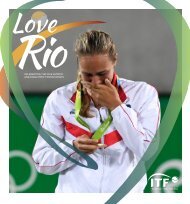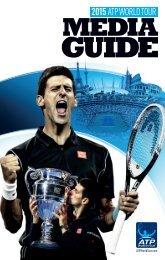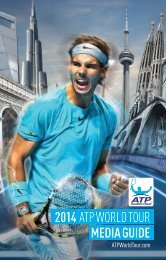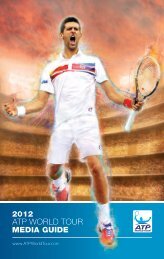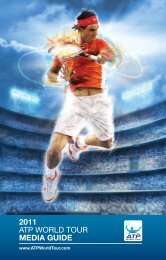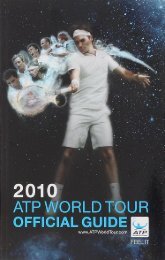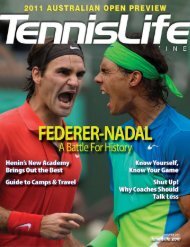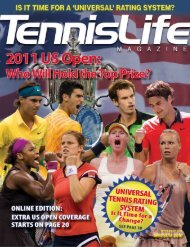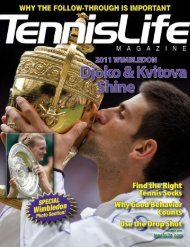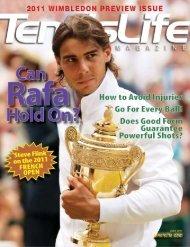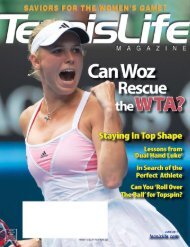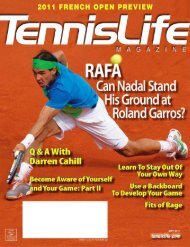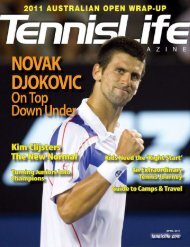A Champion's Mind - Pete Sampras
www.tennismoscow.me Insta:TENNISMOSCOW
www.tennismoscow.me Insta:TENNISMOSCOW
You also want an ePaper? Increase the reach of your titles
YUMPU automatically turns print PDFs into web optimized ePapers that Google loves.
union, is like the PGA. At the end of every year, the top eight players compete in the ATP Finals, or World<br />
Championships (lately, the event has been called the ATP Masters Cup). The players are divided into two<br />
groups of four; each group plays a round-robin, and the two men in each group with the best record in that<br />
portion go on to the four-man-knockout semifinals and final.<br />
The round-robin was a disaster for me in 1990. I got just six games off of Andre, and I lost to Stefan<br />
Edberg in straight sets, so I failed to make the semifinals. But I soothed the pain of that performance with<br />
a huge payday at a brand new and somewhat controversial event, the $6 million Grand Slam Cup.<br />
That tournament was created by the International Tennis Federation, which is the parent group of the<br />
various national federations (like our United States Tennis Association). Those affiliates of the ITF<br />
control the respective national championships, which over time evolved into the most important<br />
tournaments on the calendar. The Grand Slams, or majors, are basically the “open” (meaning open to<br />
anyone who qualifies, based on rankings) national championships of Australia, France, England, and the<br />
United States. In order to push back against the growing power of the ATP, the ITF decided that they<br />
would stage the Grand Slam Cup as a rival event to the ATP Finals. The GS Cup would bring together the<br />
top performers in the four majors for a big year-end event. It’s a legitimate idea, but we already had the<br />
ATP Finals, so all the GS Cup did was confuse people—and dump tons of money on the players.<br />
The Grand Slam Cup was based on a points system that measured the top sixteen performers in the<br />
majors, so there were always a few guys in the event who just had a good run at a major or two, and<br />
thereby qualified for the event. The prize money was insane; John McEnroe publicly criticized the event,<br />
calling the payday “obscene.” Even first-round losers were lavishly compensated, taking home six-figure<br />
paychecks, while the winner earned a mind-blowing $2 million (losing semifinalists took home a mere<br />
$450,000). Unlike the round-robin of the ATP Finals, the GS Cup was a knockout event with a sixteenman<br />
draw from the start. This meant that a guy who had played over his head at one or two majors and<br />
qualified for the Grand Slam Cup was looking at a payday he was unlikely ever to see again.<br />
The surface at the GS Cup was fast carpet, but I got mired down in three-set battles that I was lucky to<br />
win. I took out one guy who was lucky to be there (Russia’s Andrei Cherkasov), one who would emerge<br />
as my chief Wimbledon rival (Goran Ivanisevic), and my childhood rival—and the only guy from my<br />
Golden Generation to have won a Grand Slam title at that stage—Michael Chang. That brought me to the<br />
final against Brad Gilbert.<br />
Gilbert, who went on to become more famous as Andre Agassi’s coach and a television commentator<br />
than he had been as a player, was renowned for, as the title of his own book put it, winning ugly. Unlike<br />
McEnroe, Brad found nothing obscene about the money and played his heart out to get to the final. But I<br />
never had much trouble with guys who played ugly and won in straights.<br />
That year ended okay, and it prefigured the roller-coaster ride I would take in 1991. There were two<br />
reasons for my fluctuating results, and I could control one but not the other. My game was still developing.<br />
My serve-and-volley game was reliable, but I had great and not-so-great days with my return game<br />
(especially on fast surfaces), and with my ground strokes. That was the part I couldn’t control. The part<br />
that I could’ve controlled had to do with commitment—the desire to play my best and leave it all out<br />
there, win or lose, every time I stepped on the court.<br />
Winning the Open had dramatically improved my lifestyle. I could eat in the best restaurants and play<br />
golf wherever I wanted, and was catered to by people, including complete strangers, in whatever I<br />
wanted. Materially I was comfortable, but I was also uneasy in my own skin. At the same time, the<br />
pressure that came along with being a U.S. Open champ—the guy who suddenly had a bull’s-eye on his<br />
back—was very quietly and slowly wearing on me. I became a little sullen and withdrawn. I resented the<br />
expectations that people had of me.



